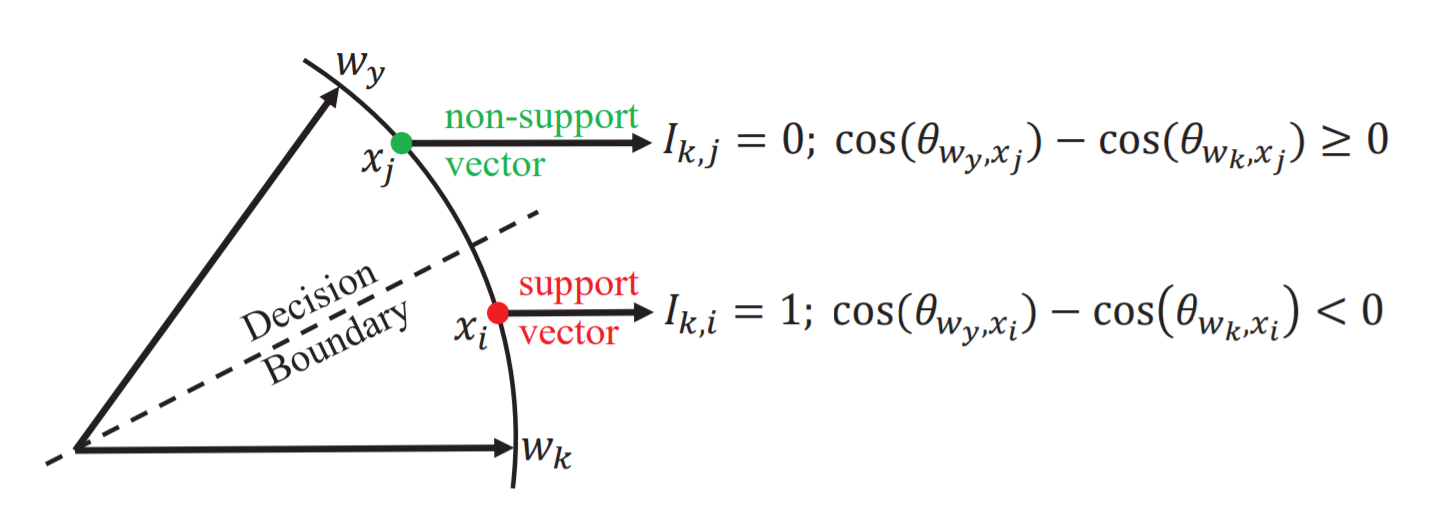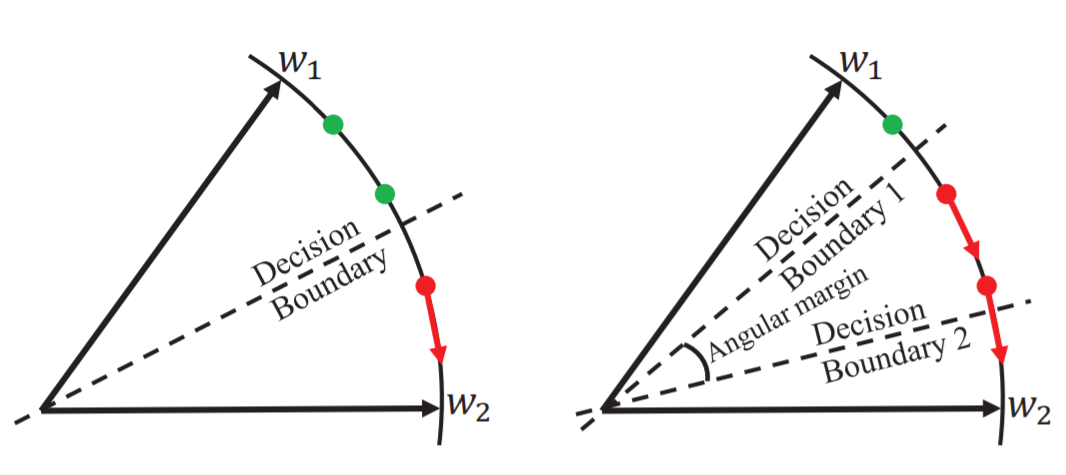[Paper Review] Support Vector Guided Softmax Loss for Face Recognition paper
Support Vector Guided Softmax Loss for Face Recognition
Wang, Xiaobo, et al. “Support vector guided softmax loss for face recognition.” arXiv preprint arXiv:1812.11317 (2018).
Abstract
-
CNN을 통해 face recognition은 상당한 발전이 있었지만, feature discrimination 아직 challenge로 남아있음
-
Learn discriminative features
- mining-based strategies : hard example mining and focal loss
- 중요한 정보에 focus를 두고 학습
- margin-based loss functions : angular, additive and additive angular margins
- ground truth class로부터 feature margin이 커지도록 학습
=> 문제점 : hard examples에 대한 기준이 애매모호하고, 다른 class로부터 구별해내는 능력이 부족함
- novel loss function인 SV-softmax(support vector guided softmax loss) 제안
- adaptively emphasizes the mis-classified points (support vectors) to guide the discriminative features learning
- 다른 class로부터 구별하는 능력이 있고, hard examples의 애매모호함을 제거할 수 있음
- 최초로 mining-based 방식과 margin-based 방식의 이점을 하나의 framework로 통합하는 시도를 함
- 몇몇 benchmarks에서 진행한 실험에서 SV-softmax의 효과를 보여줌
Introduction
-
Face recognition은 두가지 categories를 포함
-
Face identification : 주어진 face를 특정 identity로 분류
-
Face verification : 한 쌍의 face가 동일한 identity인지 판단
=> Face recognition에는 아직 많은 challenge가 존재함 (특히, MegaFace Challenge, Trillion Pairs Challenge와 같은 large-scale test datasets에서)
-
최근 face recognition task에 CNN이 사용됨
-
deep models을 학습 시키기 위해 CNN은 일반적으로 classification loss나 metric learning loss 또는 두가지를 모두 사용
=> face recognition task에 기존 loss function을 사용하면 계산비용, 성능 면에서 한계가 있음
- face feature는 서로 다른 클래스간 차별성이 존재하지만 기존 loss는 차별성을 잘 다루지 못함
=> mining-based loss functions, margin-based loss functions 등장
- Mining-based loss functions (focus on optimizing hard examples)
1) HM-Softmax (hard mining softmax) : minibatch를 high-loss를 사용하여 구성하면서 feature discrimination을 증가시킴
hard examples의 비율이 경험적으로 결정되고 easy examples이 완전히 제거됨
2) F-softmax (Focal loss) : 적은 hard examples에 focus를 두고 학습
simple hard mining softmax보다 좋은 결과
3) Yuan et al.[39] : ensemble 기법을 이용하여 다양한 hard level을 학습
=> drawback of mining-based loss : hard examples에 대한 기준이 명확하지 않고 경험적으로 선정됨
- Margin-based loss functions (increasing the feature margin between different classes)
1) Wen et al.[37] : class 내 compactness를 향상시키기 위해 각 identity의 centers를 학습하기 위한 center loss
2) Wang et al.[32] and Ranjan et al.[19] : class 내 변화량을 줄이기 위해 잘 분리된 samples에 높은 gradient를 생성하고 softmax의 정도를 조절하기 위해 scale parameter 사용
3) A-Softmax (angular margin) : ground truth class와 다른 classes 간 변화량이 커지도록 학습
학습 과정이 불안정하고 optimal parameter를 찾기 어려움 -> 학습의 안정성을 향상시키기 위한 방식들이 연구됨 (AM-Softmax)
4) AM-Softmax (additive margin loss) : optimization 과정을 안정화 시키고, 성능을 향상
5) Arc-Softmax (additive angular margin loss) : 더 명확한 geometric interpretation
=> drawback of margin-based loss : 오직 ground truth class 관점에서의 margin(self-motivation)을 크게 만들고 non-ground truth class 관점에서의 margin(other motivation)은 무시
- SV-Softmax loss
- mining-based losses와 margin-based losses 간 격차를 줄이고 의미론적으로 그들을 하나의 framework로 통합하기 위해 적응적으로 informative support vectors를 강조
- hard examples의 모호함을 제거하고, support vector에 집중하면서 다른 classes로부터의 차별성도 학습
- 기존 방식(mining,margin loss)과 SV-Softmax의 관계를 분석하고 더 나아가 feature discrimination을 향상시키기 위한 SVX-Softmax를 개발
- benchmarks(LFW, MegaFace Challenge and Trillion Pairs Challenge)에서 실험을 진행하여 SV-Softmax의 우수함을 증명
Preliminary Knowledge
- Softmax
- softmax loss : the pipeline combination of the last fully connected layer, the softmax function and the cross-entropy loss
- ground truth의 weight와 input feature vector x 간 angle을 통해 계산한 cosine similarity를 이용
- softmax loss를 통해 학습된 features는 face recognition에 대해 차별적이기보다는 분리될 수 있는 경향이 있음 (??)
- Mining-based Softmax
- informative examples에 focus를 두고 학습을 시키면서 일반적으로 더 discriminative features 생성
- 최근 연구들은 hard examples을 loss value나 model complexity를 기준으로 선정
- ground truth일 확률과 indicator function을 이용
- hard examples에 대한 정의가 애매모호하고, 그것이 성능에 영향을 끼침(sensitive performance)
- Margin-based Softmax
- margin function 사용
- 오직 ground truth class y의 관점에서만 적용하여 non-ground truth class의 영향력은 무시
Problem Formulation
- 3.1 Naive Mining-Margin Softmax Loss
eq4와 같이 단순히 결합하면 근본적인 문제가 해결되지 않음
- 3.2 Support Vector Guided Softmax Loss
- 기존의 hard examples에 대한 명확한 기준이 없는 문제를 해결하기 위해 support vectors를 사용
informative features에 focus를 두고 학습을 시키는 더 정교한 방법
- binary mask 사용 : 적응적으로 sample이 선택될지 안될지 결정
mis-classified samples이 일시적으로 강조되는 것을 확인할 수 있고, 이를 통해 hard samples이 명확하게 정의되고 그러한 sparse set에 focus를 둠
- SV-Softmax loss
t는 preset hyperparameter, h는 indicator function (t가 1이면, original softmax와 동일)
- 3.2.1 Relation to Mining-based Softmax Losses
Mining-based loss : hard samples(x1)과 easy samples(x2)을 별도로 re-weight 시킴
SV-Softmax loss : 의미론적으로 decision boundary를 따라 hard examples을 정의(support vectors)하고 support vector x1에 대한 확률을 감소시킴
- 3.2.2 Relation to Margin-based Softmax Loss
Margin-based loss : ground truth class의 관점에서의 margin function 도입
SV-Softmax loss : other non-ground truth class의 관점에서의 margin function 도입(class specific margins)
- Pipeline of SV-Softmax loss and its relations to the existing mining-based and margin-based losses
- 3.2.3 SV-X-Softmax
SV-Softmax loss는 의미론적으로 mining-based loss와 margin-based loss를 하나의 framework로 융합시킴
mining range를 증가시키기 위해 margin-based decision boundaries를 적용시킴 (SV-X-Softmax)
ground truth로부터의 self-motivation과 other classes로부터의 other-motivation을 하나의 framework로 통합시키면서 feature margin을 크게 하였고, mining-based losses을 사용하면서 의미론적으로 mining range를 크게 함














Leave a comment